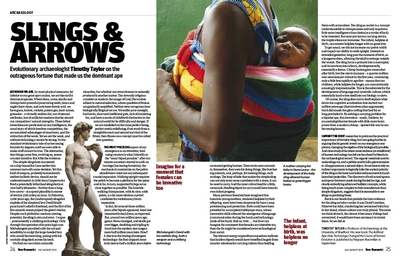 Although we are, by most physical measures, far inferior to our great ape cousins, we are the earth’s dominant species. Where lions, crocs, sharks and chimps have powerful puncturing teeth, bears and eagles have claws, and ants have formic acid, we have guns, knives, rockets, poison gas, land-mines, grenades – a virtually endless list, not of natural attributes, but of artificial creations that far exceed our competitors’ natural strengths. These lethal inventions are predicated on our intelligence, the usual story of which involves competition, the accumulated advantages of smartness, and the extinction of the weak. Yet we are the weak, and without technology cannot be strong. So the standard evolutionary tale of us becoming brainier by degrees until we were able to make stuff cannot be true. The alternative, that things came first, evolving us, seems counter-intuitive. But it fits the evidence.
Although we are, by most physical measures, far inferior to our great ape cousins, we are the earth’s dominant species. Where lions, crocs, sharks and chimps have powerful puncturing teeth, bears and eagles have claws, and ants have formic acid, we have guns, knives, rockets, poison gas, land-mines, grenades – a virtually endless list, not of natural attributes, but of artificial creations that far exceed our competitors’ natural strengths. These lethal inventions are predicated on our intelligence, the usual story of which involves competition, the accumulated advantages of smartness, and the extinction of the weak. Yet we are the weak, and without technology cannot be strong. So the standard evolutionary tale of us becoming brainier by degrees until we were able to make stuff cannot be true. The alternative, that things came first, evolving us, seems counter-intuitive. But it fits the evidence.
The simple slingshots uncovered on a ship bound for Gaza earlier this summer met with some derision. Yet this kind of weapon, probably humankind’s earliest ballistic device, should not be underestimated: in 2006 Jerzy Gasperowicz fired a potentially lethal lead slingshot just over half a kilometre – further than a long-bow arrow – at a speed plausibly in excess of 400 km (250 miles) an hour. In Palestine, 3,000 years ago, the (undisrupted) slingshot exploits of the shepherd boy David fatally punctured Goliath’s forehead, and the first of his five smooth stones pulped the giant’s brains. Despite such philistine cranium-stoving potential, the sling is also and even – I argue – preeminently a civilising technology. Only through the operation of its prior logic was Michelangelo provided with the wit and sensibility to sculpt the large-headed boy who would become king, posing with his rawhide sling slack across his back.
We find our own form naturally attractive, but whether our attractiveness is naturally produced is another matter. The devoutly religious consider us made in the image of God; Darwinists adhere to natural selection, where qualities of fitness are gradually amplified. Neither view recognises how biologically illogical we are. We suffer poor eyesight, bad backs, short and inefficient guts, lack of insulating fur, and have a mode of childbirth distinctive in the natural world for its difficulty and danger. If we are modelled on the most perfect being, perfect needs redefining; if we result from a straightforward and natural survival of the fittest, then fitness as a concept must be called into question.
The most puzzling aspect of our emergence as an inventive, tool-using creature is what I identify as the “smart biped paradox”: after our remote ancestors started to walk on two legs (becoming hominins), the mechanical constraints on the pelvis should have ruled out any subsequent cranial expansion. Walking upright requires the pelvis to become a platform for the spine and to be, in turn, supported by legs set as close together as possible. The knuckle-walking chimpanzee, with its nice, wide pelvis, is a far more obvious a priori candidate for evolutionary brain expansion.
In fact, for around three million years after bipeds appeared, head size remained locked down, as expected. But, around two million years ago, genus Homo emerged, and skulls got ever bigger, doubling and tripling to burst into the modern size range a mere half million years later. How? A clue is in the timing of emergent technology: the first chipped stone tools date to half a million years before we started getting brainier. These tools were not ends in themselves, they were for doing things, like butchering animals, and, perhaps, for making things, such as slings. The loop of hide that makes the simple sling can not only scare away a predator with a stone, it can be used to carry. And the most critical load for a little, savannah-dwelling biped to carry would have been its own infant progeny.
Many previous theorists have imagined that hominin young mothers, rendered helpless by their offspring, must have been desperate for base-camp provisioning and protection. Both could have been provided by an incipient hubby/ape-man, whose innovative skills allowed the emergence of language (communication during the hunt) and technology (tools of the hunt). Roll on 1950 . . . but if we can imagine for a moment that females are inventive too, then the fix might be considered more technological than social.
The relevant energy expenditure equations indicate that hairless bipeds would have benefited hugely from smarter solutions for carrying infants than holding them with arms alone. The sling as carrier is a concept understandable to chimpanzees and only requires a little more intelligence than theirs (or a stroke of luck) to be invented. But once you have a carrying device, the implications are immense. The infant, helpless at birth, can remain helpless longer with no great loss.
To get smart, we did not increase our pelvic width and impair our ability to walk upright. Instead we extended gestation, long past the moment of birth, as a kangaroo does, allowing the skull to enlarge outside the womb. The sling turns a primate into a marsupial, and its newborn into what is, developmentally, essentially a foetus. Chimp brains grow somewhat after birth, but the rate in humans – a quarter million new neurones per minute in the first year, continuing only a little less rapidly to age five – means that our children, while helpless for longer, are concomitantly amazingly impressionable. This is the substrate for the development of language and symbolic culture, which essentially hard-wires itself into our biology ex utero.
Of course, the sling does not in itself explain what drove the cognitive acceleration that started two million years ago (that involves other arguments), but it did smash the glass ceiling that had for so long precluded it. By solving a carrying problem for a bipedal ape, this invention – made, I believe, by an australopithecine female with little more brain power than a modern chimp – opened the way to our becoming human.
I am not the first researcher to point out the practical importance of the baby sling, but I am going further in arguing that its genetic reverb on our emergence was pivotal, changing the algebra of the biologically possible. And close study of the interconnectedness (or entailment) of human technology has left me less fazed by blanks in the archaeological record. The organic materials used to make slings rot, and a pebble used to kill a giant remains to all appearances a natural object. So we have to rely on indirect arguments to logically infer the ancient priority of the sling as the basic and initial enhancement to hand-launched projectiles. The discovery of both actual spears and spear-throwers made during the last Ice Age, and clearly embodying advanced ballistic concepts, while being much more complex in their manufacture than simple slingshots, suggests that it is reasonable to see slings as predating these.
But it is our heads that provide the best evidence for the sling as baby-carrier: it was David’s mother, Nitzevet bat Adel, comforting her ostracised baby boy in her shawl, whose culture was truly primal. The more we think about it, the clearer it becomes: if slings had not existed, it would have been necessary to invent them. So we did.
Timothy Taylor's new book The Artificial Ape: How Technology Changed the Course of Human Evolution is published by Palgrave Macmillan in September

